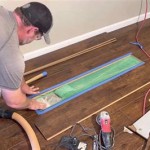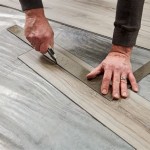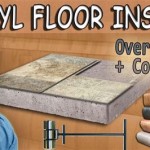Can You Put Vinyl Plank Flooring On Cement?
Vinyl plank flooring has become a popular choice for homeowners and renovators due to its durability, water resistance, and ease of installation. One common question regarding its application is whether it can be installed directly over cement. The answer is, generally, yes, but with some important considerations and preparations.
Cement Subfloor Preparation
Proper subfloor preparation is paramount for a successful vinyl plank installation. Cement subfloors must be clean, level, and dry. Any cracks, holes, or uneven areas should be addressed before laying the vinyl planks. Loose debris, dust, and old adhesive residue must be thoroughly removed. A good cleaning with a strong degreaser and a thorough rinsing will ensure a clean slate for the new flooring.
Leveling the cement is crucial. Even minor imperfections can telegraph through the vinyl planks, creating an uneven surface and potentially damaging the planks over time. Self-leveling compounds are readily available and provide a smooth, even base for the vinyl. Ensure the compound is suitable for use under vinyl flooring and follow the manufacturer’s instructions precisely.
Moisture is another critical factor. Concrete is porous and can absorb moisture from the ground. Excessive moisture can lead to mold and mildew growth under the flooring, damaging both the subfloor and the vinyl. A moisture test should be performed to determine the moisture content of the concrete. If the moisture levels are too high, a moisture barrier should be applied before installing the vinyl planks.
Types of Vinyl Plank Flooring and Installation Methods
Several types of vinyl plank flooring are available, each with its own installation method. Understanding the different types and their requirements is essential for choosing the right one for a cement subfloor.
Click-lock vinyl plank flooring:
This type features planks with interlocking edges that snap together, creating a floating floor. This method is relatively easy for DIY installation and doesn't require adhesive. An underlayment is typically recommended for added comfort and moisture protection.Glue-down vinyl plank flooring:
This type requires adhesive to bond the planks directly to the cement subfloor. While this method provides a more secure installation, it requires more expertise and careful preparation to ensure proper adhesion and a smooth finish.Loose-lay vinyl plank flooring:
This type uses friction and the weight of the planks to hold them in place. While the simplest to install, it's less common and generally not recommended for high-traffic areas or areas prone to moisture.Regardless of the type of vinyl plank flooring chosen, always follow the manufacturer’s instructions for installation. These instructions provide specific guidance on subfloor preparation, adhesive recommendations, and proper installation techniques.
Underlayment Options for Cement Subfloors
Using an underlayment offers several benefits when installing vinyl plank flooring over cement. It provides cushioning, which improves comfort underfoot, and also acts as a moisture barrier, further protecting the flooring from moisture damage. Additionally, some underlayments provide sound insulation, reducing noise transmission between floors.
Several types of underlayment are compatible with vinyl plank flooring, including foam, cork, and felt. When choosing an underlayment, consider the specific requirements of the vinyl plank flooring and the conditions of the cement subfloor. For instance, in areas prone to moisture, a waterproof underlayment is crucial.
The thickness of the underlayment is also a factor. While thicker underlayments provide more cushioning, they can also raise the height of the floor, which may require adjustments to doorways and transitions. Consult the manufacturer’s recommendations for the appropriate underlayment thickness for the chosen vinyl plank flooring.
Proper installation of the underlayment is essential for its effectiveness. Ensure the underlayment is laid flat and smooth, with seams butted tightly together and sealed with appropriate tape to prevent moisture penetration. Avoid overlapping the underlayment, as this can create uneven areas under the flooring.
By carefully considering these factors—subfloor preparation, vinyl plank type and installation method, and underlayment selection—a successful and long-lasting vinyl plank flooring installation over cement can be achieved. Always refer to the manufacturer's specific instructions for the flooring and any related products for optimal results.

How To Prepare A Concrete Floor For Vinyl Flooring Parrys

Tips For Installing Vinyl Plank Over Concrete Floors Lemon Thistle

How To Install Vinyl Plank Flooring Lifeproof Over Concrete

Lvp Flooring Installation Over Concrete Subfloor Full Instructional Builds By Maz Flooret

How To Install Vinyl Flooring On Concrete Floor Ers

Lvp Flooring Installation How To Install Luxury Vinyl Plank In A Basement Diy

Vinyl Plank Flooring On Uneven Concrete

Installing Vinyl Plank Flooring On Concrete Floor In Dallas Fort Worth Tx All American

Easy Ways To Install Vinyl Plank Flooring On Concrete

How To Install Vinyl Or Laminate Floors In A Basement Over Concrete Slab
See Also







